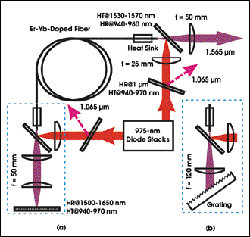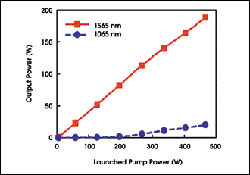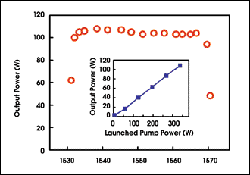
Eye-Safe, Wavelength-Tunable Fiber Laser Generates >100 W
Breck Hitz
Eye-safe lasers -- those that emit in the 1.5-µm region where the cornea does not transmit -- are important for many applications, including free-space communications, remote sensing and rangefinding.
Significant power levels often are required in these applications, but traditional eye-safe sources such as diode-pumped, Er-Yb-doped glass or crystal lasers suffer thermal distortion at the pumping intensity required for high output powers. The thermal distortion not only diminishes laser efficiency and limits output power, but also degrades the quality of the output beam. Moreover, bulk crystalline solid-state lasers have limited wavelength-tuning capability because of their relatively narrow bandwidth.
As a result of these limitations, a number of laboratories have investigated Er-Yb-doped fiber lasers, which are much less sensitive to thermal effects because of their high surface-to-volume ratio. They also have broad bandwidths because of the amorphous nature of the glass host and, hence, offer wavelength tunability. Recently, scientists at the University of Southampton in the UK demonstrated a cladding-pumped, Er-Yb-doped fiber laser that generated 188 W at a fixed wavelength of 1.57 µm, and in excess of 100 W when continuously tuned over a spectral range from 1532 to 1568 nm.

Figure 1. (a) The eye-safe fiber laser employs a dichroic back mirror to reflect the laser wavelength and reject the pump. The other resonator mirror is provided by the Fresnel reflection at the cleaved fiber facet. (b) For wavelength-tuning experiments, the researchers substituted a grating for the back mirror. Images ©OSA.
The 3-m-long double-clad fiber was pumped from both ends by a pair of diode laser stacks at 975 nm (Figure 1). The fiber's relatively short length and relatively large, 30-µm-diameter core eliminated detrimental nonlinear effects. Roughly 80 percent of the pump radiation incident on the fiber ends was launched into the fiber. Copper V-groove heat sinks at each end of the fiber removed the unlaunched pump power as well as the heat produced by the quantum defect of the Er-Yb system.
The laser's output coupling was provided by the 3.6 percent Fresnel reflection from the cleaved end-facet of the fiber. The researchers operated the laser with and without the dichroic (highly reflective at the laser wavelength and highly transmissive at the pump wavelength) back mirror. In the absence of the dichroic mirror, the cleaved fiber facet served as the second laser mirror, and the combined output beams contained more power (188 W) than the single output beam (159 W) with the dichroic mirror in place. The bidirectional pump power launched into the cladding was 466 W in both cases. The M2 of the output beam was ~1.9.

Figure 2. The slope efficiency of the 1565-nm output decreased slightly at higher power because of the parasitic lasing of ytterbium at 1065 nm. But the total power at both wavelengths was linear with pump power, indicating that further power scaling is possible without thermal effects.
The slope efficiency of the 1565-nm output decreased slightly at higher powers, the result of parasitic lasing of the ytterbium at 1065-nm (Figure 2). The researchers inserted dichroic mirrors between the laser and the pump diodes to protect the diodes from the 1065-nm radiation. The total power from the laser at both wavelengths was linear as a function of pump power, a strong indication that further power scaling of the laser is possible before thermal effects limit the output.

Figure 3. With a grating substituted for the back mirror, the laser was tunable from 1531 to 1571 nm. Inset: The output was linear with pump power.
To tune the laser's wavelength, the researchers substituted a grating for the dichroic back mirror and polished the fiber facet adjacent to the grating at 14° to disable it as a laser mirror. (They also used a shorter, 2-m fiber in the wavelength-tuning demonstration.)
They tuned the laser from 1531 to 1571 nm and measured an output power of more than 100 W between 1532 and 1568 nm (Figure 3). Again, the linearity of the output power with pump power indicates that further power scaling is feasible.
Published: September 2005